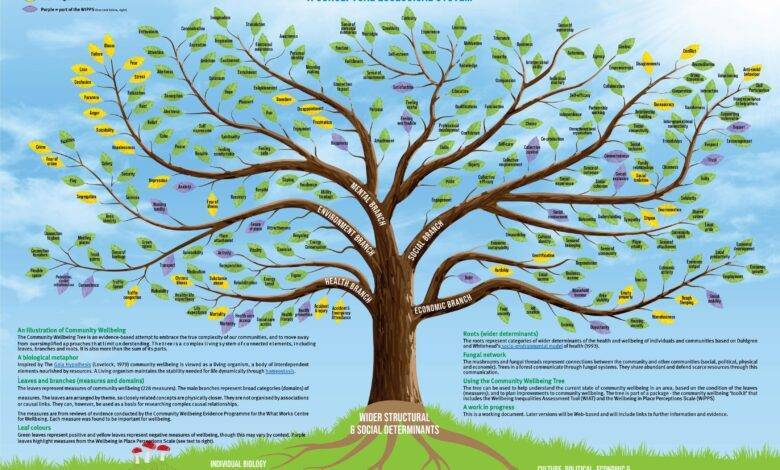
The University of Liverpool conducted research into the importance of ‘communities’ for people’s well-being.
The Community Wellbeing Tree is an evidence-based effort to embrace the true complexity of our communities and move away from oversimplified approaches to a boundless understanding.
The tree is a complex living system trunk of interconnected elements, including leaves, branches and roots. It is also more than the sum of its parts. A biological metaphor.
Inspired by the Gaia hypothesis (Lovelock, 1979), community well-being is seen as a living organism, a set of interdependent elements fed by resources. A living organism maintains the stability necessary for life dynamically through homeostasis. .
Leaves and branches (sizes and domains)
The leaves represent measures of community well-being (228 measures). The main branches represent broad categories (domains) of measures. The leaves are arranged by theme, so closely related concepts are physically closer. They are not organized by associations or causal relationships. However, they can serve as a basis for investigating complex causal relationships. These parameters come from evidence reviews conducted by the Community Wellbeing Evidence Program for the What Works Center for Wellbeing. Every action turned out to be important for well-being.
Leaf colors Green leaves represent positive and yellow leaves represent negative measures of well-being, although this may vary by context. Purple leaves mark measurements of the well-being scale in place (see text at right).
Roots (wider determinants)
The roots represent categories of broader determinants of the health and well-being of individuals and communities based on Dahlgren and Whitehead’s (1993) social-environmental model of health.
Mold network
The mushrooms and hyphae represent connections between the community and other communities (social, political, physical)
and economic). Trees in a forest communicate through fungal systems. They share profusely and thereby defend scarce resources
communication.
Using the Community Welfare Tree
The tree can be used to understand the current state of community well-being in an area, based on the condition of the leaves
(measures); and to plan improvements to community well-being.
This is a working document. Later versions will be web-based and will contain links to more information and evidence.